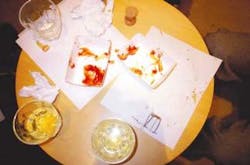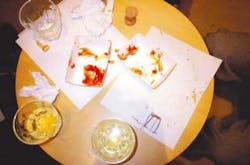A healthier break room
by Kandice Swarthout, RDH, BS
The well-planned day of a dental hygienist can quickly become hectic. If one patient arrives just 10 minutes late, we play catch up the rest of the day. We think it isn't good time management to break for a snack. We move from one procedure to the next without taking time to catch our breath or grab a snack. Don't you just love when your stomach growls in your patient's ear around 10 a.m.? Not even the sound of the high-speed suction can drown out the racket. You could offer him or her a set of headphones to spare you the embarrassment of your grumbling belly, or you could eat something!
Our bodies require more than three square meals a day to run efficiently. Studies show that eating five to six small meals or snacks during the day speeds up your metabolism. Our bodies easily process the smaller meals by using them for energy, instead of storing the calories from a large meal as fat. This leads to weight loss, more energy, and a happier, healthier lifestyle.
Mark Slavens, a personal fitness trainer in Plano, Texas, said to think of the body as a car. Put enough gas in it to get from point A to point B. Think of "Point A" as breakfast, "Point B" as your midmorning snack and so forth. Eat only the calories you need for enough energy to get to the next meal. Slavens suggests eating a meal or snack every three to four hours. Depending on your goals and calorie needs, he feels that a snack should consist of no more than 100 to 200 calories and meals should consist of about 600 calories.
He says, "People who follow multiple meal diet plans have weight loss/management success and more energy overall."
Slavens also suggests eating protein and fat with every snack or meal. Since these take longer to digest, the food stays in the gut longer and a person feels more satisfied than by eating pure carbohydrates.
I like to use my mom, Rosie, as an example of this theory. Rosie suffered a heart attack in 1999. She gained a few unwanted pounds the two years following her bypass surgery, which was not conducive to maintaining her health. She was never a breakfast eater, but after some convincing, she has one piece of whole grain toast with all-natural peanut butter for breakfast every morning and a snack a few hours before lunch. Soon, the pounds began to melt away. She is back to a size six and has more energy to do the things she loves. She believes this is the result of smaller, more frequent meals.
Many Americans shy away from fats fearing weight gain. Yet the human body requires a certain amount of fat to maintain health.
Unfortunately, the food industry has bombarded foods with harmful fat called hydrogenated oil or trans-fat, which is found in most processed foods, peanut butters, "nutrition bars," and fast food. Trans-fats can be detrimental to heart health because they lower the "good" HDL cholesterol and increase the "bad" LDL cholesterol. In my opinion, this is the most important ingredient to avoid. Read labels carefully and try to avoid products that contain this harmful fat. While reading labels can be time consuming at first, you will soon discover your favorite "trans-fat" free products.
Susan Kliener, Ph.D., R.D., calls high-fructose corn syrup "The Devil's Candy." It shuts off the switches of appetite control, and makes it easy to consume a high quantity of calories in one meal. The World Health Organization recommends that people limit their intake of sugar added to foods to less than 10 percent of calories. Tufts University Health and Nutrition Department reports that the natural sugars in fruit and milk are acceptable. Trouble comes with the added sugar in foods that are otherwise not sweet. The report states, "Sugar is added to spaghetti sauce, soup, oatmeal, ketchup, and many other products. We're eating more of it every year. In 1999, Americans downed an average of 158 pounds of sweeteners per person — sugar, high-fructose corn syrup, honey, molasses, and maple syrup. That is almost a 30 percent increase from the 123 pounds per person in 1980."
Yes, preparing healthy meals and snacks can be very time consuming. Learn to set aside time from your busy schedule to prepare healthy meals in advance. Prepare enough chicken salad for two to three days, or a large bowl of soup that can be easily heated and enjoyed at lunchtime. Many of us have allowed ourselves to become victims of time restraints. As a result, health, well-being and peace of mind suffer. There is no replacement for your body. Educate yourself about the dangers of the typical American diet, and the poisons placed in many foods and beverages. Help your children avoid becoming victims of the food industries' attempts to make them lifetime consumers of poor quality and addictive food products.
I present you with a challenge. Does the company you buy your meat, dairy, and egg products from give its animals antibiotics and hormones? How safe is your local drinking water? Are you a diet soda addict who is unaware of the dangers of artificial sweeteners? Does your favorite fast food restaurant use trans-fats? Does your spaghetti sauce contain high-fructose corn syrup? Do you really know what you put into your body? I challenge you to ask yourself these questions.
I challenge you to educate yourself and take a step towards a healthier future. I challenge you to take on daily eating habits that result in more energy and a better life for you and your family. Take charge of what goes in your body and enjoy health now and for a lifetime.
Kandice Swarthout, RDH, BS, is a graduate of Texas Women's University. She practices with a cosmetic and comprehensive care team in Dallas, Texas. Kandice is a Black Belt in American Freestyle Martial Arts and a kickbox fitness instructor. She has a passion for nutrition and fitness and is on a quest to educate herself and others on the dangers of the modern American diet. Kandice can be contacted at [email protected].
References:1. Mark Slavens. Personal Fit Trainer 24-Hour Fitness, Plano, Texas. Certified by the American Council on Exercise, National Academy of Sports Medicine and The Cooper Aerobics Institute.
2. Men's Health. April 2003. "The Devil's Candy" by Susan M. Keiner, Ph.D., R.D. Page 118.
3. Tufts University Health and Nutrition Letter. May 2003, Volume 21, Number 3. "Getting By On Less Sweet Stuff". Page 1.
What types of foods should we eat for these smaller, more frequent meals to maintain desired weight and energy? Focusing on "real" whole foods, as opposed to the unhealthy ingredients found in most processed foods, is a good start. Health-conscience hygienists share their favorite snacks below.
Esther a hygienist in Dallas, recommends a Luna Glow bar for a midmorning snack. She said one Luna bar provides 100 percent of her recommended folate intake. Luna is made from soy protein and natural sweeteners. Soy protein can be beneficial to women of all ages to help balance estrogen levels. Also, there is no high-fructose corn syrup in Luna products. Our bodies lack the ability to properly burn high-fructose corn syrup as energy; therefore, we keep it in the form of stored fat!
Debbie of Mesquite, Texas, enjoys string cheese for snack. She also recommends low sugar yogurt (with no aspartame) for a quick bite. As a breast cancer survivor, Debbie is aware of what she consumes and knows that she needs healthy fats to maintain her weight, and plenty of calcium for strong bones. The string cheese is quick, accessible, and enough to satisfy her hunger until lunch. It is individually wrapped and low calorie. Recent studies show that eating a proper amount of daily calcium may improve the body's ability to burn fat. Both cheese and yogurt supply a healthy dose of calcium.
Carrie of Ontario, Canada, enjoys fruit for her midmorning snack. She recommends fruits that are easy to peel like bananas or clementines. Fruit is an excellent source of vitamins and a friendly way to get carbohydrates. Some fruits, like bananas, have a high glycemic index, which rapidly raises blood sugar. Other fruits, such as blueberries and strawberries, create a slower release of insulin and allow our bodies to burn the carbohydrates more efficiently over a longer period of time. The high glycemic fruits are acceptable, just remember that moderation is the key.
Matt of San Francisco eats a slow burning carbohydrate/protein breakfast packed full of energy. He puts strawberries, blueberries, flax seed oil, apple cider, and whey protein or soy powder in his blender. He takes this on the go for a great start to his day, and it is a well-rounded snack or meal for any time of day.
Heather also of Ontario, likes to snack on almonds mixed with dried cranberries. The almonds are full of high quality fats that our bodies require to maintain health.
Though snacks are an important part of our daily calorie intake, it is necessary to make healthy breakfast, lunch, and dinner choices to maintain proper energy levels. Use the same rules for higher calorie meals as with the 100 to 200 calorie snacks. Choose a balance of protein, healthy fat, and slow-burning carbohydrates.
Breakfast is the necessary fuel needed for morning energy and brainpower. Eating breakfast can result in a more efficient, calorie-burning metabolism. Breakfast can be as simple as a bowl of cereal, or as hearty as eggs and veggies. One of my favorite cereals is called "Optimum Power" by Nature's Path. The main ingredient is organic whole-wheat bran, and it has 10 grams of fiber! It tastes awesome and has a ton of power packed ingredients. Don't mistake it for the cardboard flavored "healthy" cereals.
Lunch is a crucial part of our workday because it fuels us to take on the second half of our busy schedules. Consuming a lunch consisting of fast-burning carbohydrates and unhealthy fats can leave you feeling tired in the late afternoon. Fast-burning carbohydrates are white foods such as white rice, white pasta, white bread, and bagels. Foods with added sugar such as high-fructose corn syrup can also slow you down. Make healthy choices like tuna or chicken salad on a bed of greens with tomatoes and red onions. When choosing greens, remember that mixed greens with darker colored leaves pack a much healthier punch than iceberg lettuce. Make sure your lunch is the right balance of carbs, protein, and fat, and make sure the ingredients are real foods and not processed junk.
Dinner can be the most challenging meal of the day. When you're tired you want something fast and easy that will satisfy everyone in the family. Whole-grain pasta dishes, casserole dishes and soups are hearty, quick meals. Prepare enough to take to lunch the next day. Also, there are a variety of white flour pasta alternatives. My favorites are made from brown rice or quinoa. The texture is slightly different than white flour pasta, but the taste is great, and both are slow-burning carbohydrates for sustained energy and less stored fat.

